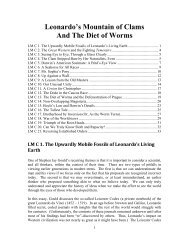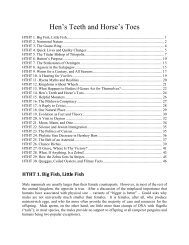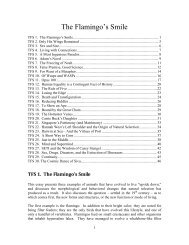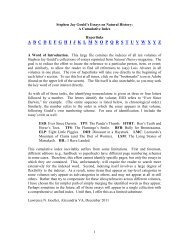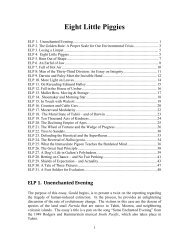key ways. Prior to 1994, no fossil Tardigrada from any period had ever been found; butat a conference in that year, German paleontologists Walossek and Müller reported thatthey had made just such a discovery in pristine Cambrian strata in Siberia. Water bearsare therefore also very likely products of the Cambrian explosion.The third group, the Pentastomida or tongue worms, are all parasites, and almost all livein terrestrial vertebrates – which did not exist during the Cambrian period. Further, somegenetic evidence had been reported that suggested that this phylum had diverged fromcrustaceans (one of the main groups of arthropods) between 350 and 225 million yearsago, well after the Cambrian explosion. Finding fossil evidence of Pentastomida tocontradict this evidence would seem impossible, for two reasons. First, they are allcompletely soft-bodied. Secondly, the degeneration of unneeded parts in parasites makestracing their ancestry especially difficult; how would you recognize the fossil of a freelivingPentastomida if you found one? Yet this is exactly what happened – by the samegroup that found the fossil Tardigrada. This time, the data came from a Cambrian bed inSweden, but with an unusual method of preservation – phosphatization [discussed againin LSM 21]. This fossilization process only works on very small organisms, by forminga hollow phosphate-based shell around soft-bodied creatures. This shell preservesexquisite detail, and can be exposed by dissolving the material in a weak acid to removethe background material. The details clearly indicate many features that are unique toliving Pentastomida. What about the genetic evidence? Gould quotes from one of thepapers, showing that the authors (in good faith) appear to have misinterpreted their data.Tongue worms appear to date back to the Cambrian explosion as well.DIH 10. Cordelia’s Dilemma“Publication bias” was, when Gould wrote this, a small area of study about and within thefield of science. Gould came to appreciate this fact when he stumbled on a 1988 paperwritten by Colin B. Begg and Jesse A. Berlin entitled “Publication bias: a problem ininterpreting medical data.” The thesis, as their title indicates, is that studies of drugs thatyield significant medical effects are submitted, and accepted, more often for publicationthan studies of equal quality that do not show such effects. This is not, Gould tells us, anact of dishonesty, but merely a reflection of human nature. As humans, we like stories,and “nothing happened” makes a dull story. As such, publication bias appears in allfields of science, not only medicine. Gould notes that he first ran across thisphenomenon while writing his book The Mismeasure of Man, which was on the subjectof attempts by scientists to quantify intelligence and behavior, but often resulted injustifying racism and sexism.Although a study showing that a drug is safe but not effective for a particular ailmentmay not be interesting (and therefore less likely to be published), at least the negativeresult is recognized. There is another kind of publication bias, Gould states: one in whichthe negative result is not recognized, but instead attributed to low-quality data, poorresolution, or a bad experimental design; no result, rather than a negative result. Gouldoffers a name for this phenomenon: “Cordelia’s dilemma.” Cordelia is the third daughterof King Lear in Shakespeare’s play of that name. She is pressured by the king to join her12
two sisters in praising him excessively. As the only one of his daughters who truly loveshim, she feels her only two options are to succumb and lie, or to remain faithful – byremaining silent. She chooses the latter, which the king misconstrues; rather thaninterpreting her silence as an act of faith and love, he takes it for what it appears to be:nothing. By analogy, Gould argues, Cordelia’s dilemma in science is to interpret “nochange over time” as “no data.”Gould, of course, has a personal stake in this issue. Stasis, one of the key concepts ofpunctuated equilibrium, involves the identification of “no change” as, itself, important; inthe famous phrase from the first paper he and Niles Eldredge wrote on PE in 1972, “stasisis data.” Gould describes how his graduate advisor used certain statistical techniques toidentify changes in 50 species of Devonian brachiopods over an extended period; notfinding any, he did not publish, and in fact changed fields! <strong>In</strong> the operating paradigm ofhis advisor and almost everyone else in the profession, evolution is a continuous, ongoingprocess. Therefore, the absence of change (Cordelia’s silence) was not an indication ofsomething important, but simply “nothing.” Gould tells us that, whether punctuatedequilibrium holds up in the long run or not, he takes pride in motivating the communityto look for stasis, and to recognize its theoretical importance.Gould was motivated to write this essay, he tells us, by the contemporary (1992)publication of a study of stasis at the next higher taxonomic level – that of genus – byAnn Budd and Anthony Coates. PE refers only to the origin and continuity of species.When most or all of the species in that genus evolve in a similar direction, whether byabrupt punctuations or gradual and continuous phyletic gradualism, the community refersto this as a trend. Gould states that there are many trends in the fossil record, such as theincreasing brain size of hominids over the past few million years [see ESD 22] andreduction in the number of toes on horses. [He notes in BFB 11 that the horse is actuallya bad example. Also, in their original 1972 paper, Gould and Eldredge argue that trendsin natural history can be explained in terms of both phyletic gradualism and punctuatedequilibrium.] <strong>In</strong> an analogy to Cordelia’s dilemma at the species level, a commonlyunrecognized assumption is that all trends are directional; that is, gradual but continuouschange toward “something.” Budd and Coates examined species of the coral genusMontastraea (still important today) over the 80 million year span of the Cretaceousperiod. What they found was that, while species came and went, the attributes of thegenus as a whole appeared to oscillate back and forth between certain limits; after 80million years, species looked pretty much the same as they did at the beginning. Buddand Coates refer to this as “non-progressive evolution.” Gould is delighted, primarily onthe grounds that twenty years earlier this phenomenon would almost certainly not havebeen reported.He is careful not to claim that there are no trends in most of natural history. Rather, it isthat they are not as universal as was commonly believed; this should be recognized, heclaims, if for no other reason than to better appreciate the importance of the “real” trends.[However, his 1996 book Full House – written a few years later – argues that progressiveevents and trends are actually quite rare in natural history.]13
- Page 4 and 5: cloud (“nebula”) of gas and dus
- Page 6 and 7: goodness, and is both intelligent a
- Page 9: The second news story involves the
- Page 14: DIH 11. Lucy on the Earth in Stasis
- Page 17: directly resulted in a mass extinct
- Page 20 and 21: Edgar Allan Poe, it turns out, wrot
- Page 22 and 23: things male, while the beautiful is
- Page 24 and 25: interest, until the entrepreneur of
- Page 26 and 27: essay is that scientists, for all t
- Page 28 and 29: DIH 23. The Smoking Gun of Eugenics
- Page 30 and 31: half-Jewish meant Jewish, while qua
- Page 32 and 33: Darwin’s theory, like Adam Smith
- Page 34 and 35: What might a better definition of t
- Page 36 and 37: type of soil, amount of rain, and s
- Page 38 and 39: Case Four, in Gould’s words, is
- Page 40 and 41: multiplying his findings by the num
- Page 42 and 43: other departments, something that r
- Page 44 and 45: Linnaeus, Gould states, did not sim
- Page 46: greatly prefers these metaphors, on




